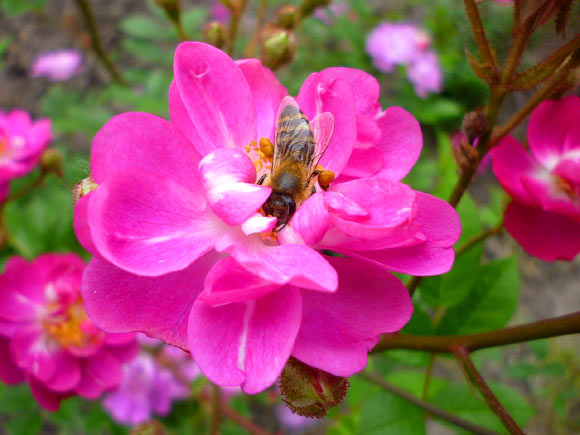Nicotine and other chemicals found in flowers of tobacco and other plants could be the right prescription for diseased bumblebees and bees, says a group of researchers led by Dr Leif Richardson of Dartmouth College.

This image shows a bee pollinating a flower of a wild rose.
Dr Richardson and his colleagues found that chemicals in floral nectar, including the alkaloids anabasine and nicotine, the iridoid glycoside catalpol and the terpenoid thymol, significantly reduce parasite infection in bumblebees and bees.
The results, published in the journal Proceedings of the Royal Society B, suggest that growing plants high in these compounds around farm fields could create a natural medicine cabinet that improves survival of diseased bees and pollination of crops.
“Our novel results highlight that secondary metabolites in floral nectar may play a vital role in reducing bee-parasite interactions,” said Prof Rebecca Irwin of Dartmouth College, the senior author on the study.
The team studied parasite infections in bumblebees, which like honey bees are important pollinators that are in decline around the world, a trend that threatens fruits, vegetables and other crops that make up much of the food supply for people.
The scientists hypothesized that some nectar compounds could reduce parasite infections in bees.
They inoculated individual bumblebees with an intestinal parasite, Crithidia bombi, and tested effects of eight naturally occurring nectar chemicals on parasite population growth.
The results showed that consumption of these chemicals lessened the intensity of infection by up to 81 percent, which could significantly reduce the spread of parasites within and between colonies of bumblebees and bees.
“Secondary metabolites strongly reduced parasite load, with significant effects of alkaloids, terpenoids and iridoid glycosides ranging from 61 to 81 %,” the scientists wrote in the paper.
_____
Leif L. Richardson et al. Secondary metabolites in floral nectar reduce parasite infections in bumblebees. Proceedings of the Royal Society B, published online February 18, 2015; doi: 10.1098/rspb.2014.2471







